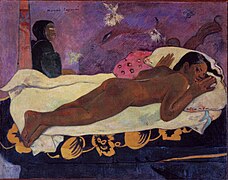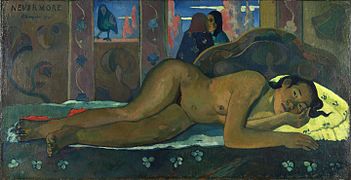Self-portrait as a Tahitian

|
| Self-portrait as a Tahitian |
|---|
| Amrita Sher-Gil , 1934 |
| Oil on canvas |
| 90 × 56 cm |
Self-portrait as a Tahitian is a painting by the Indian - Hungarian artist Amrita Sher-Gil from 1934. It shows the artist with a naked torso in front of a Japanese-looking background and takes up motifs from the works of Paul Gauguin and Vincent van Gogh . It is owned by Navina and Vivan Sundaram , niece and nephew Sher-Gils.
description
The painting shows Sher-Gil from the waist up in three-quarter profile . Her upper body is bare and she has a white, Polynesian -looking cloth wrapped around her waist . She keeps her arms crossed in front of her hips. She has tied her long black hair in a ponytail. Her lips are full and red. Sher-Gil directs his gaze to the left of the viewer. The shadow of a man can be seen behind her. In the background you can see Japanese figures, next to a seated man and two women in kimonos , a pagoda-like building and the strict lines of a Japanese courtyard.
Origin background
Amrita Sher-Gil was born in Budapest in 1913 as the daughter of a Sikh aristocrat from the Punjab and a Jewish-Hungarian opera singer . In 1921 the family moved to Shimla , India , where they spent most of the next eight years. Between 1929 and 1934, Sher-Gil lived with her family in Paris , where she studied art at the École des Beaux-Arts, among other things . During this time, in addition to pictures of models, she also painted 19 self-portraits, the last of which was Self-Portrait as a Tahitian in 1934. In the same year she returned to India, where she now devoted herself to studying the common people there in her paintings. Self-portrait as a Tahitian was created exactly at the transition of her work from the representation of European to the representation of Indian models.
Templates and interpretation
Amrita Sher-Gil was a supporter of the work of the French artist Paul Gauguin , which was also reflected in her works. Self-portrait as a Tahitian is the clearest reference to Gauguin in Sher-Gil's work, as it takes up the pictures of Tahitians that Gauguin had painted during two stays in Tahiti . During these stays he had several young women as lovers. Probably the best known of them is Teha'amana, a 13- or 14-year-old whom he depicted in some of his works, including the painting The Spirit of the Dead Wakes Up . In these works Gauguin presented the South Sea island as a sexual paradise. In addition, he often portrayed the women in his pictures as if they were offering themselves for “consumption” by a man. In addition, her beauty in the pictures is closely linked to her closeness to nature and her supposedly animal sexuality. Examples of this are for Saloni Mathur, in addition to The Spirit of the Dead Wakes Up , Nevermore from the year 1897. Sher-Gil clearly differs from this depiction through her posture and her painted lips on the self-portrait and gives the impression of an independent personality. In her distant gaze, Saloni Mathur sees a reference to Sher-Gil's longing for India, which she described in the Indian newspaper The Hindu in 1933 . Saloni Mathur also sees a reference to Gauguin in the shadow of the man who can be seen behind Sher-Gil, as Gauguin had depicted himself in some pictures.
The Japanese motifs and figures in the background of the painting can be understood as a reference to so-called Japonism , i.e. the influence of Japanese art on the art of the West and especially France. Among the artists who picked up Japanese motifs in their paintings was Gauguin and Vincent van Gogh , whom Sher-Gil also admired. An example of this is van Gogh's portrait of Père Tanguy , in the background of which Japanese pictures and prints can be seen.
reception
The series Re-take of Amrita by the Indian artist Vivan Sundaram , a nephew of Amrita Sher-Gil, consists of a series of digital black and white photo montages. They combine photos taken by, among others, Umrao Singh Sher-Gil, Amrita's father, with paintings by Amrita Sher-Gil. This includes the montage Self as Tahitian , in the background of which a section from a self-portrait as a Tahitian can be seen. The foreground is a photo showing Amrita Sher-Gil in a bathing suit in Hungary. It was recorded in 1938 by her Hungarian cousin and husband Victor Egan.
Self-portrait as a Tahitian woman has also appeared on several books dealing with the life of Amrita Sher-Gil. The first volume of a compilation of letters and letters published by Vivan Sundaram shows Sher-Gil's painting on the cover. The novel Der Milchozean by the German author Richard Weihe, who fictionally deals with the artist's life, also shows a section of the painting on the title page.
literature
- Elizabeth C. Childs: Taking Back Teha'amana: Feminist Interventions in Gauguin's Legacy . In: Norma Broude (Ed.): Gaugin's Challenge. New Perspectives After Postmodernism . Bloomsbury Visual Art, New York 2018, p. 229–250 (English, limited preview in Google Book Search).
- Saloni Mathur: A Retake of Sher-Gil's Self-Portrait as Tahitian . In: Critical Inquiry . tape 37 , no. 3 . The University of Chicago Press, 2011, pp. 515-544 , doi : 10.1086 / 659356 (English, societyforasianart.org [PDF; 1.5 MB ]).
Individual evidence
- ↑ Amrita Sher-Gil. In: documenta 14. Retrieved on April 11, 2019 .
- ↑ Saloni Mathur: A Retake of Sher-Gil's Self-Portrait as Tahitian . 2011, p. 526.
- ↑ Saloni Mathur: A Retake of Sher-Gil's Self-Portrait as Tahitian . 2011, pp. 516-518.
- ↑ Elizabeth C. Childs: Taking Back Teha'amana: Feminist Interventions in Gauguin's Legacy. 2018, p. 238.
- ↑ Elizabeth C. Childs: Taking Back Teha'amana: Feminist Interventions in Gauguin's Legacy. 2018, p. 231.
- ↑ Saloni Mathur: A Retake of Sher-Gil's Self-Portrait as Tahitian . 2011, p. 521.
- ↑ Saloni Mathur: A Retake of Sher-Gil's Self-Portrait as Tahitian . 2011, p. 534.
- ↑ Saloni Mathur: A Retake of Sher-Gil's Self-Portrait as Tahitian . 2011, pp. 521-522.
- ↑ Elizabeth C. Childs: Taking Back Teha'amana: Feminist Interventions in Gauguin's Legacy. 2018, p. 241.
- ↑ Saloni Mathur: A Retake of Sher-Gil's Self-Portrait as Tahitian . 2011, p. 528.
- ↑ Anujah Fernando: Some thoughts on Re-take of Amrita by Vivan Sundaram . In: Julia Binter (ed.): The blind spot. Bremen and art in the colonial era . Dietrich Reimer Verlag, Berlin 2017, ISBN 978-3-496-01590-1 , p. 108-111 .
- ↑ Vivan Sundaram (Ed.): Amrita Sher-Gil. A Self-Portrait in Letters and Writings . Tulika Books, New Delhi 2011, ISBN 978-81-89487-59-1 (English).
- ↑ Richard Weihe: The Milky Ocean. Narrative with six pictures . Elster, Zurich 2010, ISBN 978-3-907668-83-2 .


